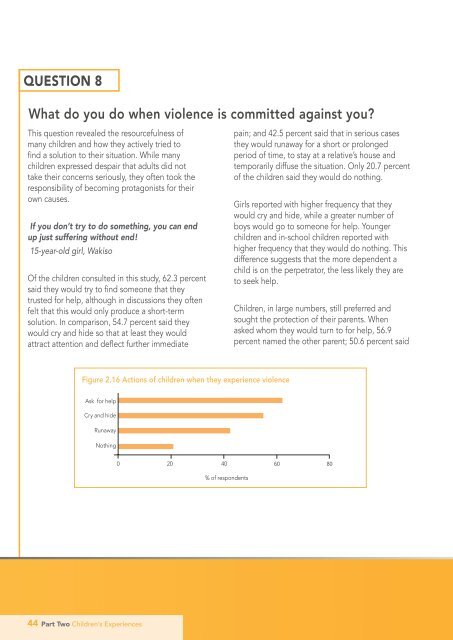Violence against children, the voices of Ugandan ... - Raising Voices
Violence against children, the voices of Ugandan ... - Raising Voices
Violence against children, the voices of Ugandan ... - Raising Voices
You also want an ePaper? Increase the reach of your titles
YUMPU automatically turns print PDFs into web optimized ePapers that Google loves.
QUESTION 8What do you do when violence is committed <strong>against</strong> you?This question revealed <strong>the</strong> resourcefulness <strong>of</strong>many <strong>children</strong> and how <strong>the</strong>y actively tried t<strong>of</strong>ind a solution to <strong>the</strong>ir situation. While many<strong>children</strong> expressed despair that adults did nottake <strong>the</strong>ir concerns seriously, <strong>the</strong>y <strong>of</strong>ten took <strong>the</strong>responsibility <strong>of</strong> becoming protagonists for <strong>the</strong>irown causes.If you don’t try to do something, you can endup just suffering without end!15-year-old girl, WakisoOf <strong>the</strong> <strong>children</strong> consulted in this study, 62.3 percentsaid <strong>the</strong>y would try to find someone that <strong>the</strong>ytrusted for help, although in discussions <strong>the</strong>y <strong>of</strong>tenfelt that this would only produce a short-termsolution. In comparison, 54.7 percent said <strong>the</strong>ywould cry and hide so that at least <strong>the</strong>y wouldattract attention and deflect fur<strong>the</strong>r immediatepain; and 42.5 percent said that in serious cases<strong>the</strong>y would runaway for a short or prolongedperiod <strong>of</strong> time, to stay at a relative’s house andtemporarily diffuse <strong>the</strong> situation. Only 20.7 percent<strong>of</strong> <strong>the</strong> <strong>children</strong> said <strong>the</strong>y would do nothing.Girls reported with higher frequency that <strong>the</strong>ywould cry and hide, while a greater number <strong>of</strong>boys would go to someone for help. Younger<strong>children</strong> and in-school <strong>children</strong> reported withhigher frequency that <strong>the</strong>y would do nothing. Thisdifference suggests that <strong>the</strong> more dependent achild is on <strong>the</strong> perpetrator, <strong>the</strong> less likely <strong>the</strong>y areto seek help.Children, in large numbers, still preferred andsought <strong>the</strong> protection <strong>of</strong> <strong>the</strong>ir parents. Whenasked whom <strong>the</strong>y would turn to for help, 56.9percent named <strong>the</strong> o<strong>the</strong>r parent; 50.6 percent saidFigure 2.16 Actions <strong>of</strong> <strong>children</strong> when <strong>the</strong>y experience violenceAsk for helpCry and hideRunawayNothing0 20 40 60 80% <strong>of</strong> respondents44 Part Two Children’s Experiences
















